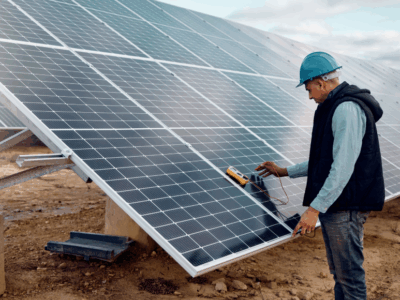Texas is becoming the United States’ renewable energy hub, already setting records for its wind power and solar array development across the state. Enel, the multinational energy provider, is no stranger to solar deployment, but the company is thinking strategically about the full sustainability of photovoltaic systems.
Enel North America says it inked the largest dual-use solar contract in the U.S. when it signed a deal with Texas Solar Sheep Co. for more than 6,000 sheep across eight solar farms. The sheep will serve as natural landscapers, grazing the field and maintaining grass length while contributing to soil health.
They are set to cover 10,100 acres of Enel’s land, an area 12 times bigger than Central Park in New York City — roughly 75% of Manhattan’s total land.
“We’re proud to partner with Enel North America on one of the biggest agrivoltaics programs in the U.S.,” JR Howard, owner of Texas Solar Sheep, said in a statement. “We applaud Enel’s commitment to dual land use solar facilities and look forward to expanding Texas agriculture along with solar energy production in the state.”
The National Renewable Energy Laboratory asserts the combined benefits of preserving habitats and grazing livestock at solar sites, which improve soil health, improve water efficiency, and reduce maintenance and operational costs.

Photo Courtesy Tanner Yould
“By prioritizing sheep grazing for land management, we demonstrate how solar and agriculture can coexist while ensuring optimal performance of our solar facilities,” Marcus Krembs, head of external relations and sustainability at Enel North America, said in a press release. “Additionally, our sheep grazing commitment supports ecosystem services and the local economy.”
The American Solar Grazing Association, with its over 800 members across 45 states, says this deal is “one the most significant single contracts for dual-use solar.” It estimates more than 100,000 acres of agrivoltaic land is being grazed in the U.S.
Enel is already seeing the benefits. Some sites contracted for sheep grazing have experienced a 200% improvement in soil health. Sheep manure is used as a natural fertilizer in compost. The fluffy animals also attract pollinators like bees, as many solar sites are in pollinator-friendly habitats. The grazing allows native plants like wildflowers to bloom, attracting bees, butterflies, and other pollinators.

Photo Courtesy Annie Sprat
Sheep grazing is becoming a more common practice and not exclusively for agrivoltaic set-ups. Sheep are used as landscapers in France at World War I historical sites to avoid lawnmowers accidentally cutting up hidden land mines.
Other solar firms like Lightsource contracted shepherds for their solar fields, seeking the full benefits Enel desires. Although not in the sheep genus, bison grazing has been tapped as one way to restore Great Plain habitats.
Agrivoltaic practices are likely to increase as more renewable energy structures are deployed. Maximizing land use is a major part of sustainability, and sheep offer other benefits like wool for clothing and serve as a food source, if necessary. “Solar grazing is at the forefront of a booming agrivoltaics industry, and we are seeing more and more leaders in the solar industry investing in long-lasting partnerships with farmers and creating new opportunities for American agriculture,” Kevin Richardson, outreach director at the American Solar Grazing Association, commented in a statement.





